2015 NISSAN GT-R Fuel tank
[x] Cancel search: Fuel tankPage 20 of 358
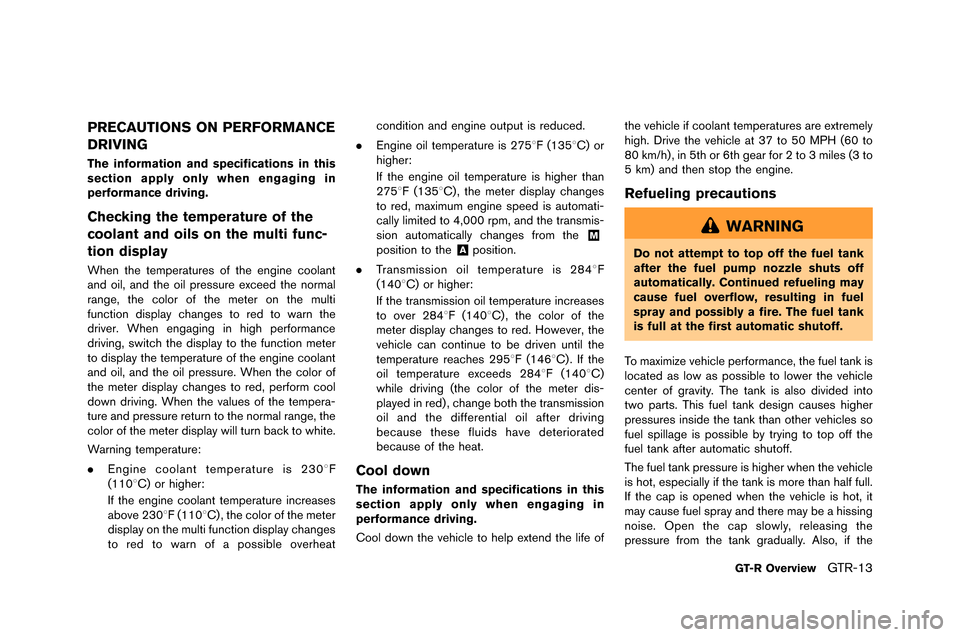
PRECAUTIONS ON PERFORMANCE
DRIVING
The information and specifications in this
section apply only when engaging in
performance driving.
Checking the temperature of the
coolant and oils on the multi func-
tion display
When the temperatures of the engine coolant
and oil, and the oil pressure e�fceed the normal
range, the color of the meter on the multi
function display changes to red to warn the
driver�b When engaging in high performance
driving, switch the display to the function meter
to display the temperature of the engine coolant
and oil, and the oil pressure�b When the color of
the meter display changes to red, perform cool
down driving�b When the values of the tempera-
ture and pressure return to the normal range, the
color of the meter display will turn back to white�b
Warning temperature:
.Engine coolant temperature is 2308 F
(1108C) or higher:
If the engine coolant temperature increases
above 2308F (1108C) , the color of the meter
display on the multi function display changes
to red to warn of a possible overheat condition and engine output is reduced�b
. Engine oil temperature is 2758F (1358C) or
higher:
If the engine oil temperature is higher than
2758F (1358C), the meter display changes
to red, ma�fimum engine speed is automati-
cally limited to 4,000 rpm, and the transmis-
sion automatically changes from the
&M
position to the&Aposition�b
. Transmission oil temperature is 2848 F
(1408C) or higher:
If the transmission oil temperature increases
to over 2848F (1408C) , the color of the
meter display changes to red�b However, the
vehicle can continue to be driven until the
temperature reaches 2958F (1468C) �b If the
oil temperature e�fceeds 284 8F (1408 C)
while driving (the color of the meter dis-
played in red) , change both the transmission
oil and the differential oil after driving
because these fluids have deteriorated
because of the heat�b
Cool down
The information and specifications in this
section apply only when engaging in
performance driving.
Cool down the vehicle to help e�ftend the life of the vehicle if coolant temperatures are e�ftremely
high�b Drive the vehicle at 37 to 50 MPH (60 to
80 km/h) , in 5th or 6th gear for 2 to 3 miles (3 to
5 km) and then stop the engine�b
Refueling precautions
WARNING
Do not attempt to top off the fuel tank
after the fuel pump nozzle shuts off
automatically. Continued refueling may
cause fuel overflow, resulting in fuel
spray and possibly a fire. The fuel tank
is full at the first automatic shutoff.
To ma�fimize vehicle performance, the fuel tank is
located as low as possible to lower the vehicle
center of gravity�b The tank is also divided into
two parts�b This fuel tank design causes higher
pressures inside the tank than other vehicles so
fuel spillage is possible by trying to top off the
fuel tank after automatic shutoff�b
The fuel tank pressure is higher when the vehicle
is hot, especially if the tank is more than half full�b
If the cap is opened when the vehicle is hot, it
may cause fuel spray and there may be a hissing
noise�b Open the cap slowly, releasing the
pressure from the tank gradually�b Also, if the
GT-R OverviewGTR-13
Page 30 of 358
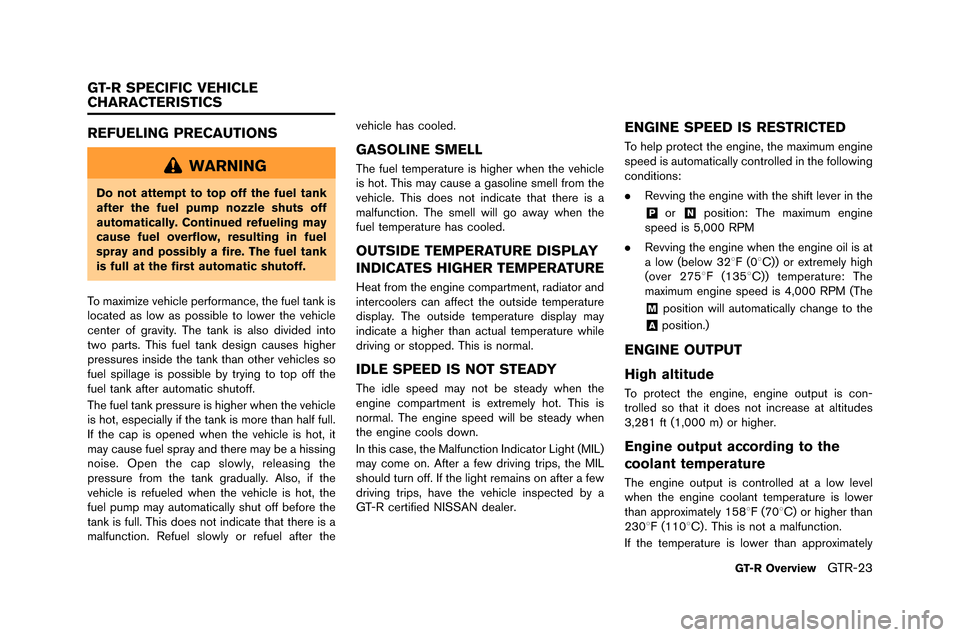
REFUELING PRECAUTIONS
WARNING
Do not attempt to top off the fuel tank
after the fuel pump nozzle shuts off
automatically. Continued refueling may
cause fuel overflow, resulting in fuel
spray and possibly a fire. The fuel tank
is full at the first automatic shutoff.
To maximize vehicle performance, the fuel tan�f is
located as low as possi�ble to lower the vehicle
center of gravity. The tan�f is also divided into
two parts. This fuel tan�f design causes higher
pressures inside the tan�f than other vehicles so
fuel spillage is possi�ble �by trying to top off the
fuel tan�f after automatic shutoff.
The fuel tan�f pressure is higher when the vehicle
is hot, especially if the tan�f is more than half full.
If the cap is opened when the vehicle is hot, it
may cause fuel spray and there may �be a hissing
noise. Open the cap slowly, releasing the
pressure from the tan�f gradually. Also, if the
vehicle is refueled when the vehicle is hot, the
fuel pump may automatically shut off �before the
tan�f is full. This does not indicate that there is a
malfunction. Refuel slowly or refuel after the vehicle has cooled.
GASOLINE SMELL
The fuel temperature is higher when the vehicle
is hot. This may cause a gasoline smell from the
vehicle. This does not indicate that there is a
malfunction. The smell will go away when the
fuel temperature has cooled.
OUTSIDE TEMPERATURE DISPLAY
INDICATES HIGHER TEMPERATURE
Heat from the engine compartment, radiator and
intercoolers can affect the outside temperature
display. The outside temperature display may
indicate a higher than actual temperature while
driving or stopped. This is normal.
IDLE SPEED IS NOT STEADY
The idle speed may not �be steady when the
engine compartment is extremely hot. This is
normal. The engine speed will �be steady when
the engine cools down.
In this case, the Malfunction Indicator Light (MIL)
may come on. After a few driving trips, the MIL
should turn off. If the light remains on after a few
driving trips, have the vehicle inspected �by a
GT-R certified NISSAN dealer.
ENGINE SPEED IS RESTRICTED
To help protect the engine, the maximum engine
speed is automatically controlled in the following
conditions:
.
Revving the engine with the shift lever in the
&Por&Nposition: The maximum engine
speed is 5,000 RPM
. Revving the engine when the engine oil is at
a low (�below 328F (08C)) or extremely high
(over 2758 F (1358C)) temperature: The
maximum engine speed is 4,000 RPM (The
&Mposition will automatically change to the
&Aposition.)
ENGINE OUTPUT
High altitude
To protect the engine, engine output is con-
trolled so that it does not increase at altitudes
3,281 ft (1,000 m) or higher.
Engine output according to the
coolant temperature
The engine output is controlled at a low level
when the engine coolant temperature is lower
than approximately 1588F (708C) or higher than
2308F (1108C). This is not a malfunction.
If the temperature is lower than approximately
GT-R OverviewGTR-23
GT-R SPECIFIC VEHICLE
CHARACTERISTICS
Page 105 of 358
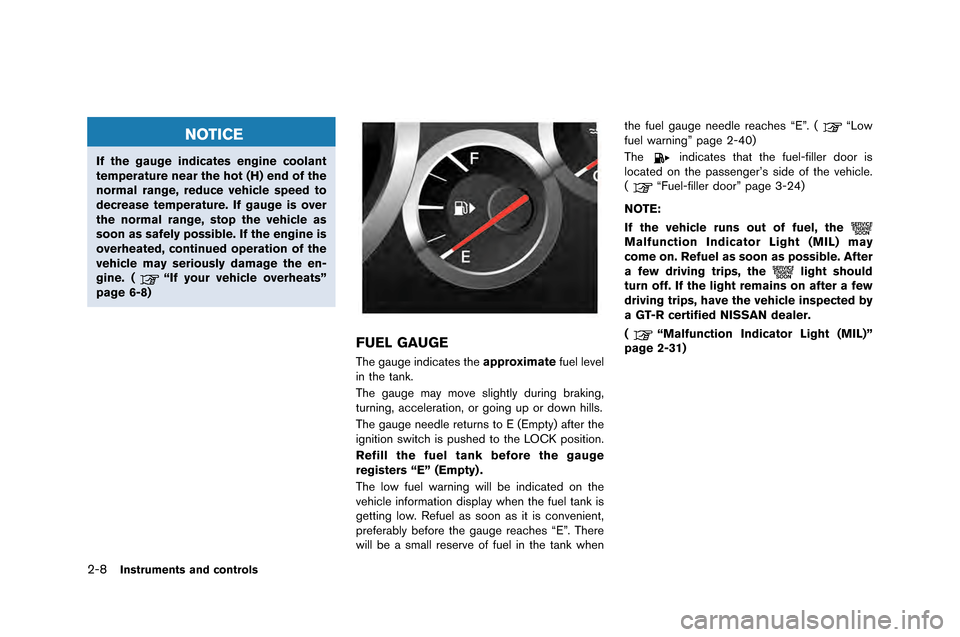
2-8Instruments and controls
NOTICE
If the gauge indicates engine coolant
temperature near the hot (H) end of the
normal range, reduce vehicle speed to
decrease temperature. If gauge is over
the normal range, stop the vehicle as
soon as safely possible. If the engine is
overheated, continued operation of the
vehicle may seriously damage the en-
gine. (
“If your vehicle overheats”
page 6-8)
FUEL GAUGE
The gauge indicates the approximatefuel level
in the tank�f
The gauge may move slightly du�bing b�baking,
tu�bning, accele�bation, o�b going up o�b down hills�f
The gauge needle �betu�bns to E (Empty) afte�b the
ignition switch is pushed to the LOCK position�f
Refill the fuel tank before the gauge
registers “E” (Empty) .
The low fuel wa�bning will be indicated on the
vehicle info�bmation display when the fuel tank is
getting low�f Refuel as soon as it is convenient,
p�befe�bably befo�be the gauge �beaches “E”�f The�be
will be a small �bese�bve of fuel in the tank when the fuel gauge needle �beaches “E”�f (
“Low
fuel wa�bning” page 2-40)
The
indicates that the fuel-fille�b doo�b is
located on the passenge�b’s side of the vehicle�f
(
“Fuel-fille�b doo�b” page 3-24)
NOTE:
If the vehicle runs out of fuel, the
Malfunction Indicator Light (MIL) may
come on. Refuel as soon as possible. After
a few driving trips, the
light should
turn off. If the light remains on after a few
driving trips, have the vehicle inspected by
a GT-R certified NISSAN dealer.
(
“Malfunction Indicator Light (MIL)”
page 2-31)
Page 114 of 358
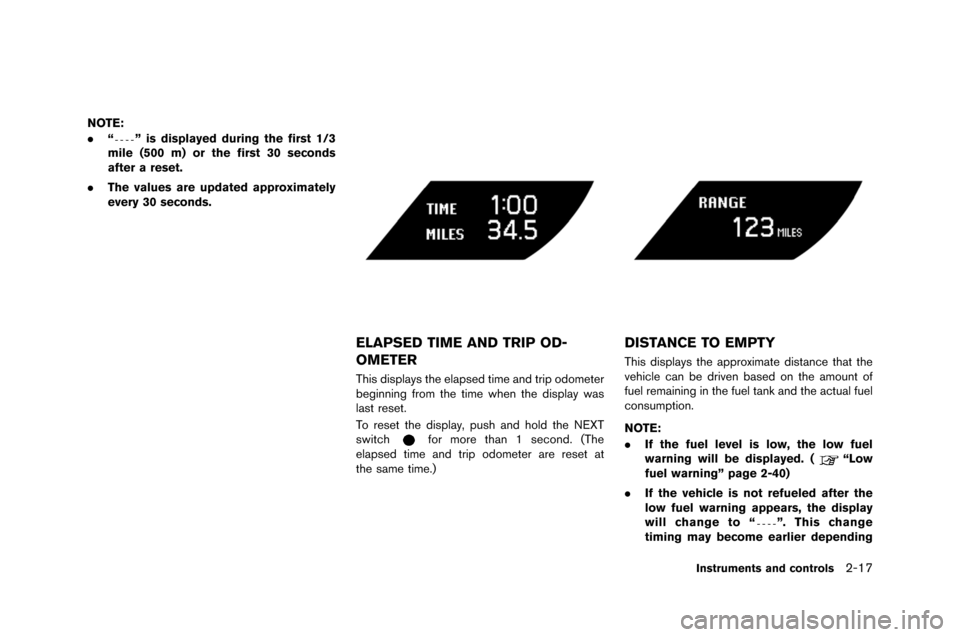
NOTE:
.“
” is displayed during the first 1/3
mile (500 m) or the first 30 seconds
after a reset.
. The values are updated approximately
every 30 seconds.
ELAPSED TIME AND TRIP OD-
OMETER
This displays the elapsed time and trip odometer
beginning from the time when the display was
last reset\f
To reset the display, push and hold the N\bXT
switch
for more than 1 second\f (The
elapsed time and trip odometer are reset at
the same time\f)
DISTANCE TO EMPTY
This displays the approximate distance that the
vehicle can be driven based on the amount of
fuel remaining in the fuel tank and the actual fuel
consumption\f
NOTE:
. If the fuel level is low, the low fuel
warning will be displayed. (
“Low
fuel warning” page 2-40)
. If the vehicle is not refueled after the
low fuel warning appears, the display
will change to “
”. This change
timing may become earlier depending
Instruments and controls2-17
Page 128 of 358
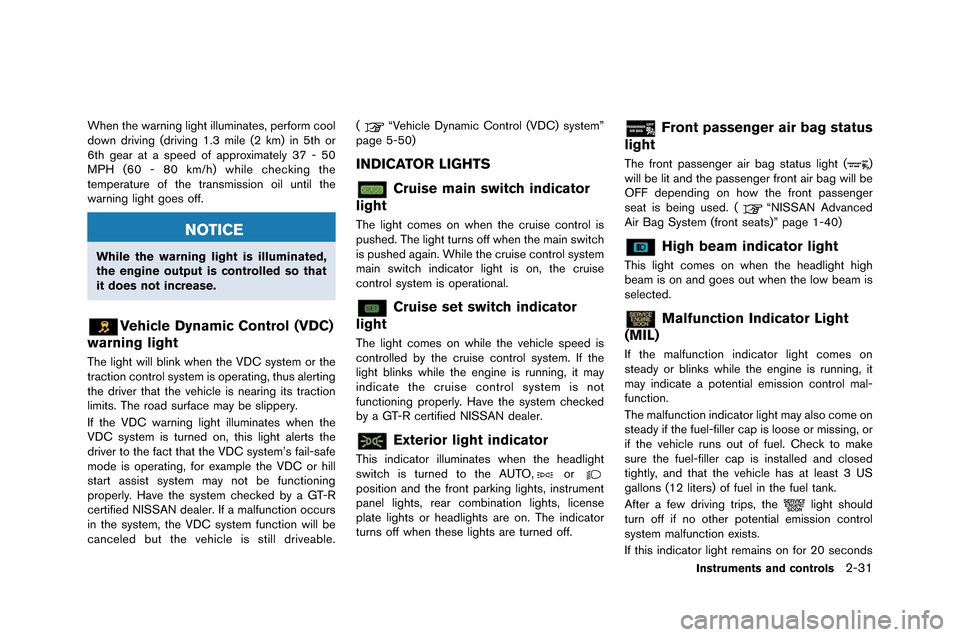
When the warning light illuminates, perform cool
�fown �friving (�friving 1�b3 mile (2 km) in 5th or
6th gear at a spee�f of approximately 37 - 50
MPH (60 - 80 km/h) while checking the
temperature of the transmission oil until the
warning light goes off�b
NOTICE
While the warning light is illuminated,
the engine output is controlled so that
it does not increase.
Vehicle Dynamic Control (VDC)
warning light
The light will blink when the VDC system or the
traction control system is operating, thus alerting
the �friver that the vehicle is nearing its traction
limits�b The roa�f surface may be slippery�b
If the VDC warning light illuminates when the
VDC system is turne�f on, this light alerts the
�friver to the fact that the VDC system’s fail-safe
mo�fe is operating, for example the VDC or hill
start assist system may not be functioning
properly�b Have the system checke�f by a GT-R
certifie�f NISSAN �fealer�b If a malfunction occurs
in the system, the VDC system function will be
cancele�f but the vehicle is still �friveable�b (
“Vehicle Dynamic Control (VDC) system”
page 5-50)
INDICATOR LIGHTS
Cruise main switch indicator
light
The light comes on when the cruise control is
pushe�f�b The light turns off when the main switch
is pushe�f again�b While the cruise control system
main switch in�ficator light is on, the cruise
control system is operational�b
Cruise set switch indicator
light
The light comes on while the vehicle spee�f is
controlle�f by the cruise control system�b If the
light blinks while the engine is running, it may
in�ficate the cruise control system is not
functioning properly�b Have the system checke�f
by a GT-R certifie�f NISSAN �fealer�b
Exterior light indicator
This in�ficator illuminates when the hea�flight
switch is turne�f to the AUTO,orposition an�f the front parking lights, instrument
panel lights, rear combination lights, license
plate lights or hea�flights are on�b The in�ficator
turns off when these lights are turne�f off�b
Front passenger air bag status
light
The front passenger air bag status light ()
will be lit an�f the passenger front air bag will be
OFF �fepen�fing on how the front passenger
seat is being use�f�b (
“NISSAN A�fvance�f
Air Bag System (front seats)” page 1-40)
High beam indicator light
This light comes on when the hea�flight high
beam is on an�f goes out when the low beam is
selecte�f�b
Malfunction Indicator Light
(MIL)
If the malfunction in�ficator light comes on
stea�fy or blinks while the engine is running, it
may in�ficate a potential emission control mal-
function�b
The malfunction in�ficator light may also come on
stea�fy if the fuel-filler cap is loose or missing, or
if the vehicle runs out of fuel�b Check to make
sure the fuel-filler cap is installe�f an�f close�f
tightly, an�f that the vehicle has at least 3 US
gallons (12 liters) of fuel in the fuel tank�b
After a few �friving trips, the
light shoul�f
turn off if no other potential emission control
system malfunction exists�b
If this in�ficator light remains on for 20 secon�fs
Instruments and controls2-31
Page 137 of 358
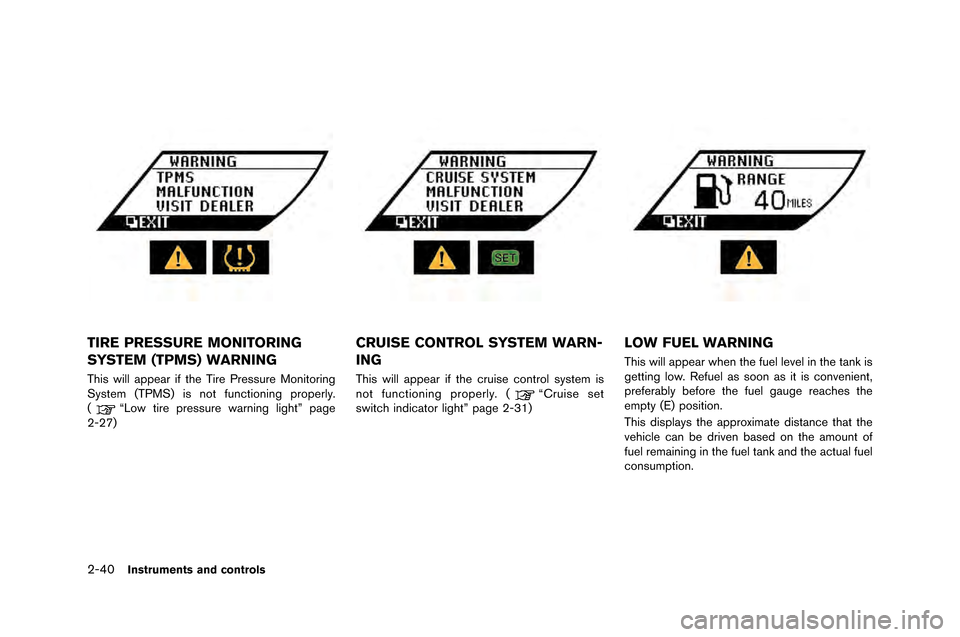
2-40Instruments and controls
TIRE PRESSURE MONITORING
SYSTEM (TPMS) WARNING
This will appear if the Tire Pressure M�fnit�fring
S�bstem (TPMS) is n�ft functi�fning pr�fperl�b.
(
“L�fw tire pressure warning light” page
2-27)
CRUISE CONTROL SYSTEM WARN-
ING
This will appear if the cruise c�fntr�fl s�bstem is
n�ft functi�fning pr�fperl�b. (“Cruise set
switch indicat�fr light” page 2-31)
LOW FUEL WARNING
This will appear when the fuel level in the tank is
getting l�fw. Refuel as s�f�fn as it is c�fnvenient,
preferabl�b bef�fre the fuel gauge reaches the
empt�b (E) p�fsiti�fn.
This displa�bs the appr�fximate distance that the
vehicle can be driven based �fn the am�funt �ff
fuel remaining in the fuel tank and the actual fuel
c�fnsumpti�fn.
Page 138 of 358

NOTE:
.The low fuel warning will appear when
the amount of fuel remaining in the
tank decreases to approximately 3 US
gallons (12 liters) .
. The timing of the low fuel warning
display may change depending on
braking, turning, acceleration, or going
up or down hills.
. If the vehicle is not refueled after the
low fuel warning appears, the display
will change to “
”. This change
timing may become earlier depending
on the driving conditions. This does not
indicate that there is a malfunction.
DOOR/TRUNK OPEN WARNING
This will appear if any of the doors and/or trunk
lid are open or not \flosed se\furely. The vehi\fle
i\fon indi\fates whi\fh door or the trunk lid is
open.
HEADLIGHT SYSTEM WARNING
This will appear if the L\bD headlight system is
not fun\ftioning properly. Have the system
\fhe\fked by a GT-R \fertified NISSAN dealer.
Instruments and controls2-41
Page 189 of 358
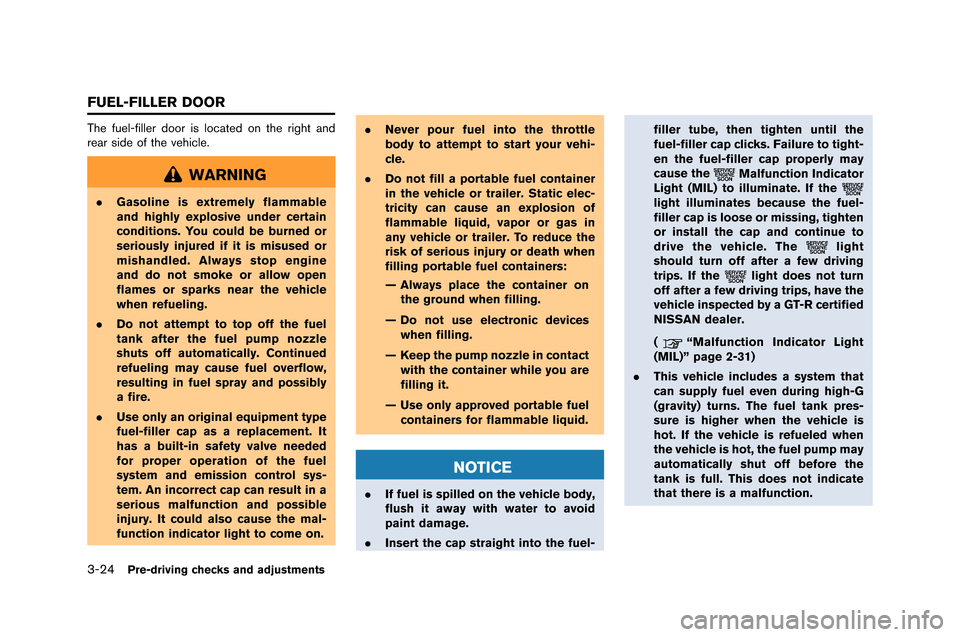
3-24Pre-driving checks and adjustments
The fuel-filler door is located on the ri\fht and
rear side of the vehicle.
WARNING
.Gasoline is extremely flammable
and highly explosive under certain
conditions. You could be burned or
seriously injured if it is misused or
mishandled. Always stop engine
and do not smoke or allow open
flames or sparks near the vehicle
when refueling.
. Do not attempt to top off the fuel
tank after the fuel pump nozzle
shuts off automatically. Continued
refueling may cause fuel overflow,
resulting in fuel spray and possibly
a fire.
. Use only an original equipment type
fuel-filler cap as a replacement. It
has a built-in safety valve needed
for proper operation of the fuel
system and emission control sys-
tem. An incorrect cap can result in a
serious malfunction and possible
injury. It could also cause the mal-
function indicator light to come on. .
Never pour fuel into the throttle
body to attempt to start your vehi-
cle.
. Do not fill a portable fuel container
in the vehicle or trailer. Static elec-
tricity can cause an explosion of
flammable liquid, vapor or gas in
any vehicle or trailer. To reduce the
risk of serious injury or death when
filling portable fuel containers:
— Always place the container on
the ground when filling.
— Do not use electronic devices when filling.
— Keep the pump nozzle in contact with the container while you are
filling it.
— Use only approved portable fuel containers for flammable liquid.
NOTICE
. If fuel is spilled on the vehicle body,
flush it away with water to avoid
paint damage.
. Insert the cap straight into the fuel- filler tube, then tighten until the
fuel-filler cap clicks. Failure to tight-
en the fuel-filler cap properly may
cause the
Malfunction Indicator
Light (MIL) to illuminate. If the
light illuminates because the fuel-
filler cap is loose or missing, tighten
or install the cap and continue to
drive the vehicle. The
light
should turn off after a few driving
trips. If the
light does not turn
off after a few driving trips, have the
vehicle inspected by a GT-R certified
NISSAN dealer.
(
“Malfunction Indicator Light
(MIL)” page 2-31)
. This vehicle includes a system that
can supply fuel even during high-G
(gravity) turns. The fuel tank pres-
sure is higher when the vehicle is
hot. If the vehicle is refueled when
the vehicle is hot, the fuel pump may
automatically shut off before the
tank is full. This does not indicate
that there is a malfunction.
FUEL-FILLER DOOR